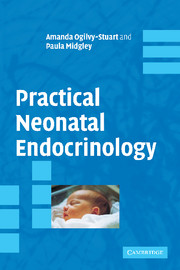Book contents
- Frontmatter
- Contents
- Acknowledgements
- Introduction
- 1 Hyperglycaemia
- 2 Hypoglycaemia
- 3 Management of hyperinsulinism
- 4 Hypoglycaemia in infant of a diabetic mother
- 5 Dysmorphic features
- 6 Micropenis
- 7 Hypopituitarism
- 8 Ambiguous genitalia (male): XY disorders of sex development
- 9 Cryptorchidism
- 10 Ambiguous genitalia (female): XX disorders of sex development
- 11 Pigmented scrotum
- 12 Adrenal failure
- 13 Collapse
- 14 Hypotension
- 15 Hyponatraemia
- 16 Hyperkalaemia
- 17 Hypernatraemia
- 18 Maternal steroid excess
- 19 Hypercalcaemia
- 20 Hypocalcaemia
- 21 Investigation and management of babies of mothers with thyroid disease
- 22 Maternal or familial thyroid disease
- 23 Goitre
- 24 Abnormal neonatal thyroid function tests
- 25 Hypothyroxinaemia in preterm infants
- Appendix 1 Calculation of glucose infusion rate
- Appendix 2 Dynamic tests
- Appendix 3 Normal ranges
- Appendix 4 Biochemistry samples
- Appendix 5 Formulary
- Index
4 - Hypoglycaemia in infant of a diabetic mother
Published online by Cambridge University Press: 15 February 2010
- Frontmatter
- Contents
- Acknowledgements
- Introduction
- 1 Hyperglycaemia
- 2 Hypoglycaemia
- 3 Management of hyperinsulinism
- 4 Hypoglycaemia in infant of a diabetic mother
- 5 Dysmorphic features
- 6 Micropenis
- 7 Hypopituitarism
- 8 Ambiguous genitalia (male): XY disorders of sex development
- 9 Cryptorchidism
- 10 Ambiguous genitalia (female): XX disorders of sex development
- 11 Pigmented scrotum
- 12 Adrenal failure
- 13 Collapse
- 14 Hypotension
- 15 Hyponatraemia
- 16 Hyperkalaemia
- 17 Hypernatraemia
- 18 Maternal steroid excess
- 19 Hypercalcaemia
- 20 Hypocalcaemia
- 21 Investigation and management of babies of mothers with thyroid disease
- 22 Maternal or familial thyroid disease
- 23 Goitre
- 24 Abnormal neonatal thyroid function tests
- 25 Hypothyroxinaemia in preterm infants
- Appendix 1 Calculation of glucose infusion rate
- Appendix 2 Dynamic tests
- Appendix 3 Normal ranges
- Appendix 4 Biochemistry samples
- Appendix 5 Formulary
- Index
Summary
Clinical presentation
Hypoglycaemia in infants of diabetic mothers should be anticipated and all infants should have early and regular glucose measurements until these are stable.
Hypoglycaemia may be asymptomatic or symptomatic.
Approach to the problem
Expectant management in all infants of diabetic mothers.
Early enteral feeds.
Regular (1–2 hourly) blood sugar measurements for first 12 h.
Differential diagnosis
Other causes of hypoglycaemia (see Chapter 2).
Investigations
Blood glucose level.
Other investigations for hypoglycaemia are not usually required unless hypoglycaemia is persistent.
Calcium and magnesium levels are required in symptomatic babies as symptoms overlap.
Haematocrit should be assessed if the baby appears plethoric or blood sugar is difficult to control (dilutional exchange transfusion may be required if the baby is polycythaemic).
Management
Immediate
If able to tolerate enteral feeds, increase the volume and frequency of the feeds.
If unable to tolerate feeds, commence an intravenous (IV) infusion and titrate the quantity of glucose to maintain the blood glucose concentration >2.6 mmol/L. Use a higher concentration of glucose via a central line (silastic long-line or umbilical venous catheter) rather than excess volumes of 10% dextrose as the latter is likely to result in fluid overload and hyponatraemia.
If IV access is difficult, intramuscular glucagon (100–200 µg/kg/dose) or buccal hypostop (40% glucose polymer, 1 mL/kg) may restore euglycaemia and buy time to achieve vascular access.
[…]
- Type
- Chapter
- Information
- Practical Neonatal Endocrinology , pp. 27 - 30Publisher: Cambridge University PressPrint publication year: 2006



